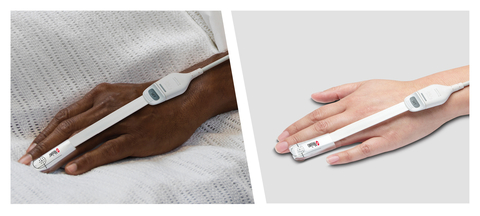Financial News
New Peer-Reviewed Study Finds That Masimo SET® Pulse Oximetry Measures Accurately on Both Black and White People Even During Low Perfusion
Masimo (NASDAQ: MASI) today announced the findings of a retrospective, peer-reviewed study published in the Journal of Clinical Monitoring and Computing in which Dr. Vikrant Sharma, along with Dr. Steven J. Barker, Dr. William C. Wilson, and colleagues at Masimo performed a focused analysis of previously published data to evaluate the impact of low perfusion on the performance of Masimo SET® pulse oximetry across a variety of skin pigmentations.1 The analysis demonstrated that Masimo RD SET® sensors accurately measured oxygen saturation (SpO2) for both Black and White subjects when perfusion index (Pi) was normal and when Pi was low – adding to the body of evidence that Masimo SET® pulse oximetry delivers accurate values across the skin tone range, with no clinically significant difference in accuracy or bias, even in challenging conditions.
This press release features multimedia. View the full release here: https://www.businesswire.com/news/home/20240208426806/en/

Masimo RD SET® (Photo: Business Wire)
In a study published in 2023, Drs. Barker and Wilson analyzed Masimo laboratory data obtained from self-identified Black and White volunteer subjects to evaluate differences in Masimo pulse oximetry accuracy and bias on the basis of skin tone. To do so, they reviewed more than 7,000 paired data samples (collected between 2015 and 2021) from 75 subjects (39 Black and 36 White) and found no clinically significant difference in accuracy or bias.2
For this newly published study, noting that low peripheral perfusion is a “recognized confounder of conventional pulse oximetry” and in light of concerns that low perfusion combined with dark skin pigmentation might decrease pulse oximetry’s accuracy, the investigators sought to determine whether accuracy on Black or White subjects was impacted by a subject’s perfusion index (Pi) with Masimo SET® pulse oximetry. To that end, they abstracted Pi values from their dataset, and divided them into “low perfusion” (Pi ≤ 1) and “normal perfusion” (Pi > 1) groups. They then performed statistical analyses to determine bias (the mean difference between SpO2 and arterial oxygen saturation [SaO2]), precision (the standard deviation of the difference), and accuracy (root-mean-square error, or ARMS*).
The researchers found that in the normal perfusion group, comparing SpO2 to SaO2 values, there was overall bias and precision of +0.18% ± 1.34%, with accuracy of 1.37% ARMS. For the subset of Black subjects, there was bias and precision of -0.26% ± 1.37%, and for White subjects, -0.12% ± 1.31%. In the low perfusion group, there was overall bias and precision of 0.48% ± 1.59%, with accuracy of 1.64% ARMS. For Black subjects, bias and precision were 0.19% ± 1.53%, and for White subjects, 0.91% ± 1.57%.
Based on their analysis, the authors concluded, “Masimo SET® pulse oximeters with RD SET® sensors are accurate for individuals of both Black and White races when Pi is normal, as well as during conditions when Pi is low. The ARMS for all conditions studied is well within FDA standards. This study was conducted in healthy volunteers during well-controlled laboratory desaturations, and results could vary under certain challenging clinical conditions.”
However, the authors noted that controlling conditions in the laboratory setting helps “minimize confounders that are present in clinical scenarios, allowing for greater focus on the topics of skin tone and Pi. Indeed, abnormal hemoglobin species (e.g., carboxyhemoglobin and methemoglobin) [known clinical SpO2 confounders] were measured and reported in the earlier paper by Barker and Wilson, and the values were similar (statistically the same) between Black and White groups.2 Also, one can only ethically conduct desaturation studies using healthy volunteer subjects in a safe setting.”
@Masimo | #Masimo
*ARMS accuracy is a statistical calculation of the difference between device measurements and reference measurements. Approximately two-thirds of the device measurements fell within +/- ARMS of the reference measurements in a controlled study.
About Masimo
Masimo (NASDAQ: MASI) is a global medical technology company that develops and produces a wide array of industry-leading monitoring technologies, including innovative measurements, sensors, patient monitors, and automation and connectivity solutions. In addition, Masimo Consumer Audio is home to eight legendary audio brands, including Bowers & Wilkins, Denon, Marantz, and Polk Audio. Our mission is to improve life, improve patient outcomes, and reduce the cost of care. Masimo SET® Measure-through Motion and Low Perfusion™ pulse oximetry, introduced in 1995, has been shown in over 100 independent and objective studies to outperform other pulse oximetry technologies.3 Masimo SET® has also been shown to help clinicians reduce severe retinopathy of prematurity in neonates,4 improve CCHD screening in newborns5 and, when used for continuous monitoring with Masimo Patient SafetyNet™ in post-surgical wards, reduce rapid response team activations, ICU transfers, and costs.6-9 Masimo SET® is estimated to be used on more than 200 million patients in leading hospitals and other healthcare settings around the world,10 and is the primary pulse oximetry at 9 of the top 10 hospitals as ranked in the 2022-23 U.S. News and World Report Best Hospitals Honor Roll.11 In 2005, Masimo introduced rainbow® Pulse CO-Oximetry technology, allowing noninvasive and continuous monitoring of blood constituents that previously could only be measured invasively, including total hemoglobin (SpHb®), oxygen content (SpOC™), carboxyhemoglobin (SpCO®), methemoglobin (SpMet®), Pleth Variability Index (PVi®), RPVi™ (rainbow® PVi), and Oxygen Reserve Index (ORi™). In 2013, Masimo introduced the Root® Patient Monitoring and Connectivity Platform, built from the ground up to be as flexible and expandable as possible to facilitate the addition of other Masimo and third-party monitoring technologies; key Masimo additions include Next Generation SedLine® Brain Function Monitoring, O3® Regional Oximetry, and ISA™ Capnography with NomoLine® sampling lines. Masimo’s family of continuous and spot-check monitoring Pulse CO-Oximeters® includes devices designed for use in a variety of clinical and non-clinical scenarios, including tetherless, wearable technology, such as Radius-7®, Radius PPG®, and Radius VSM™, portable devices like Rad-67®, fingertip pulse oximeters like MightySat® Rx, and devices available for use both in the hospital and at home, such as Rad-97® and the Masimo W1® medical watch. Masimo hospital and home automation and connectivity solutions are centered around the Masimo Hospital Automation™ platform, and include Iris® Gateway, iSirona™, Patient SafetyNet, Replica®, Halo ION®, UniView®, UniView :60™, and Masimo SafetyNet®. Its growing portfolio of health and wellness solutions includes Radius Tº®, Masimo W1, and Masimo Stork™. Additional information about Masimo and its products may be found at www.masimo.com. Published clinical studies on Masimo products can be found at www.masimo.com/evidence/featured-studies/feature/.
RPVi has not received FDA 510(k) clearance and is not available for sale in the United States. The use of the trademark Patient SafetyNet is under license from University HealthSystem Consortium.
References
- Sharma V, Barker S, Sorci R, Park L, Wilson W. Racial effects on Masimo pulse oximetry: impact of low perfusion index. J Clin Monit Comput. 19 Jan 2024. https://doi.org/10.1007/s10877-023-01113-2.
- Barker SJ, Wilson WC. Racial effects on Masimo pulse oximetry: a laboratory study. J Clin Monit Comput. 2023 Apr;37(2):567-574. https://doi.org/10.1007/s10877-022-00927-w.
- Published clinical studies on pulse oximetry and the benefits of Masimo SET® can be found on our website at http://www.masimo.com. Comparative studies include independent and objective studies which are comprised of abstracts presented at scientific meetings and peer-reviewed journal articles.
- Castillo A et al. Prevention of Retinopathy of Prematurity in Preterm Infants through Changes in Clinical Practice and SpO2 Technology. Acta Paediatr. 2011 Feb;100(2):188-92.
- de-Wahl Granelli A et al. Impact of pulse oximetry screening on the detection of duct dependent congenital heart disease: a Swedish prospective screening study in 39,821 newborns. BMJ. 2009;Jan 8;338.
- Taenzer A et al. Impact of pulse oximetry surveillance on rescue events and intensive care unit transfers: a before-and-after concurrence study. Anesthesiology. 2010:112(2):282-287.
- Taenzer A et al. Postoperative Monitoring – The Dartmouth Experience. Anesthesia Patient Safety Foundation Newsletter. Spring-Summer 2012.
- McGrath S et al. Surveillance Monitoring Management for General Care Units: Strategy, Design, and Implementation. The Joint Commission Journal on Quality and Patient Safety. 2016 Jul;42(7):293-302.
- McGrath S et al. Inpatient Respiratory Arrest Associated With Sedative and Analgesic Medications: Impact of Continuous Monitoring on Patient Mortality and Severe Morbidity. J Patient Saf. 2020 14 Mar. DOI: 10.1097/PTS.0000000000000696.
- Estimate: Masimo data on file.
- http://health.usnews.com/health-care/best-hospitals/articles/best-hospitals-honor-roll-and-overview.
Forward-Looking Statements
This press release includes forward-looking statements as defined in Section 27A of the Securities Act of 1933 and Section 21E of the Securities Exchange Act of 1934, in connection with the Private Securities Litigation Reform Act of 1995. These forward-looking statements include, among others, statements regarding the potential effectiveness of Masimo SET®. These forward-looking statements are based on current expectations about future events affecting us and are subject to risks and uncertainties, all of which are difficult to predict and many of which are beyond our control and could cause our actual results to differ materially and adversely from those expressed in our forward-looking statements as a result of various risk factors, including, but not limited to: risks related to our assumptions regarding the repeatability of clinical results; risks related to our belief that Masimo's unique noninvasive measurement technologies, including Masimo SET®, contribute to positive clinical outcomes and patient safety; risks that the researchers’ conclusions and findings may be inaccurate; risks related to our belief that Masimo noninvasive medical breakthroughs provide cost-effective solutions and unique advantages; risks related to COVID-19; as well as other factors discussed in the "Risk Factors" section of our most recent reports filed with the Securities and Exchange Commission ("SEC"), which may be obtained for free at the SEC's website at www.sec.gov. Although we believe that the expectations reflected in our forward-looking statements are reasonable, we do not know whether our expectations will prove correct. All forward-looking statements included in this press release are expressly qualified in their entirety by the foregoing cautionary statements. You are cautioned not to place undue reliance on these forward-looking statements, which speak only as of today's date. We do not undertake any obligation to update, amend or clarify these statements or the "Risk Factors" contained in our most recent reports filed with the SEC, whether as a result of new information, future events or otherwise, except as may be required under the applicable securities laws.
View source version on businesswire.com: https://www.businesswire.com/news/home/20240208426806/en/
Contacts
Masimo
Evan Lamb
949-396-3376
elamb@masimo.com
More News
View More




Recent Quotes
View More
Quotes delayed at least 20 minutes.
By accessing this page, you agree to the Privacy Policy and Terms Of Service.



